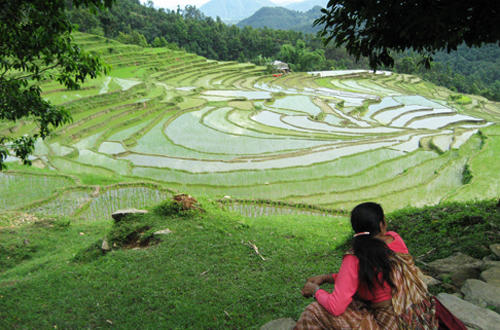Indicators – first steps to building a resilient system

Results from field testing a set of resilience indicators, developed by Bioversity International and partners in 2011, are now informing the development of a user-friendly toolkit due later this year.
Shocks and disturbances are inevitable in any system. Communities can be vulnerable to extreme weather events, market fluctuations, migration, and other forces. While we cannot prevent these things from happening, we can build more resilient systems that withstand pressure, and avoid the type of critical damage from which communities cannot recover.
But what does a resilient system look like and how do we build one? Several years ago, Bioversity International partnered with the United Nations University-Institute of Advanced Studies of Sustainability (UNU-IAS) under the Satoyama Initiative, and developed a set of indicators – 20 questions to help communities analyze the resilience of socio-ecological production landscapes (SEPLs). These indicators are spread over four broad categories: ecosystems and biodiversity protection; agricultural biodiversity; knowledge, learning and innovation; and social equity and infrastructure. Results from the indicators can be used to develop strategies to enhance resilience in a community and their landscape.
“One unusual thing about our indicators is that rather than focusing on eco-biological traits – species, habitats etc., they are more holistic, and emphasize the need for strong institutions to support communities and enhance resilience,” says Pablo Eyzaguirre, lead scientist of the Bioversity research team.
This inclusion of social and economic aspects also works well with communities: “They find the link between conservation and socio-economic issues more relevant for them,” says Diana Salvemini, coordinator of UNDP’s Community Development and Knowledge Management for the Satoyama Initiative (COMDEKS) project, which has been piloting the indicators in 20 countries since 2011.
Field testing through COMDEKS and results from Bioversity’s own field tests in Kenya, Bolivia, Cuba and Nepal, have already revealed many new insights on making communities and landscapes more resilient. “In Bolivia, for example, we found that while using agricultural biodiversity helps improve resilience, the extent to which it helps is limited if ecosystem protection is not part of the picture,” says Bioversity scientist Nadia Bergamini.
The field tests are also helping researchers improve the indicators for future use. Focus groups need to be done in a language that is tailored to the community’s context, and a good facilitator is needed to catch the smaller nuances involved. The indicators are successful in that communities are directly involved in both evaluating their resilience and developing strategies to enhance that resilience. In the case of COMDEKS, small grants are provided to community organizations to finance the action plans they’ve developed.
But linking those strategies back to national and regional policies is a challenge. “With COMDEKS we are lucky to have GEF Small Grants Programme National Steering Committees that incorporate government officials. These facilitate dialogue and inform policies that can affect the resilience of communities and their landscapes.” says Diana. But this is not the case for everyone.
Influencing policy and other issues, will be addressed in a toolkit currently being developed by the above-mentioned partners and the Institute for Global Environmental Strategies (IGES). The toolkit aims to be user-friendly, and provide instructions on how to use the indicators from the design phase to the assessment and strategic planning phase. It will also include case studies from Bioversity and COMDEKS’ experience, and contain an improved set of indicators that includes seascapes and pastoral systems (which Bioversity will be testing and refining this year in Fiji and Mongolia).
Learning, innovating and adapting are key for resilience. “A lot of global measurement systems don’t take into account that resources depend on the actions of people, and can become degraded in a very short time,” says Pablo. We need to always be aware of changing dynamics, both internal and external, and find ways to work with that change.
This article is based on exchanges made during a recent seminar series hosted at Bioversity International on ‘Indicators of resilience in socio-ecological production landscapes and seascapes (SEPLS)’. The seminar was organized in conjunction with our partners from the Satoyama Initiative, IGES, the UNDP-GEF COMDEKS Project, Fondazione Romualdo Del Bianco, and Globally Important Agricultural Heritage Systems (GIAHS). The toolkit is expected to be ready later this year.
Powerpoint presentations from the seminar are available on slideshare:
 Corinna del Bianco - Fondazione Romualdo Del Bianco
Corinna del Bianco - Fondazione Romualdo Del Bianco Diana Salvemini - COMDEKS (UNDP-GEF)
Diana Salvemini - COMDEKS (UNDP-GEF) Ikuko Matsumoto - IGES
Ikuko Matsumoto - IGES Kaoru Ichikawa - UNU-IAS/Satoyama Initiative
Kaoru Ichikawa - UNU-IAS/Satoyama Initiative Nadia Bergamini - Bioversity International
Nadia Bergamini - Bioversity International Parviz Koohafkan - GIAHS
Parviz Koohafkan - GIAHS
